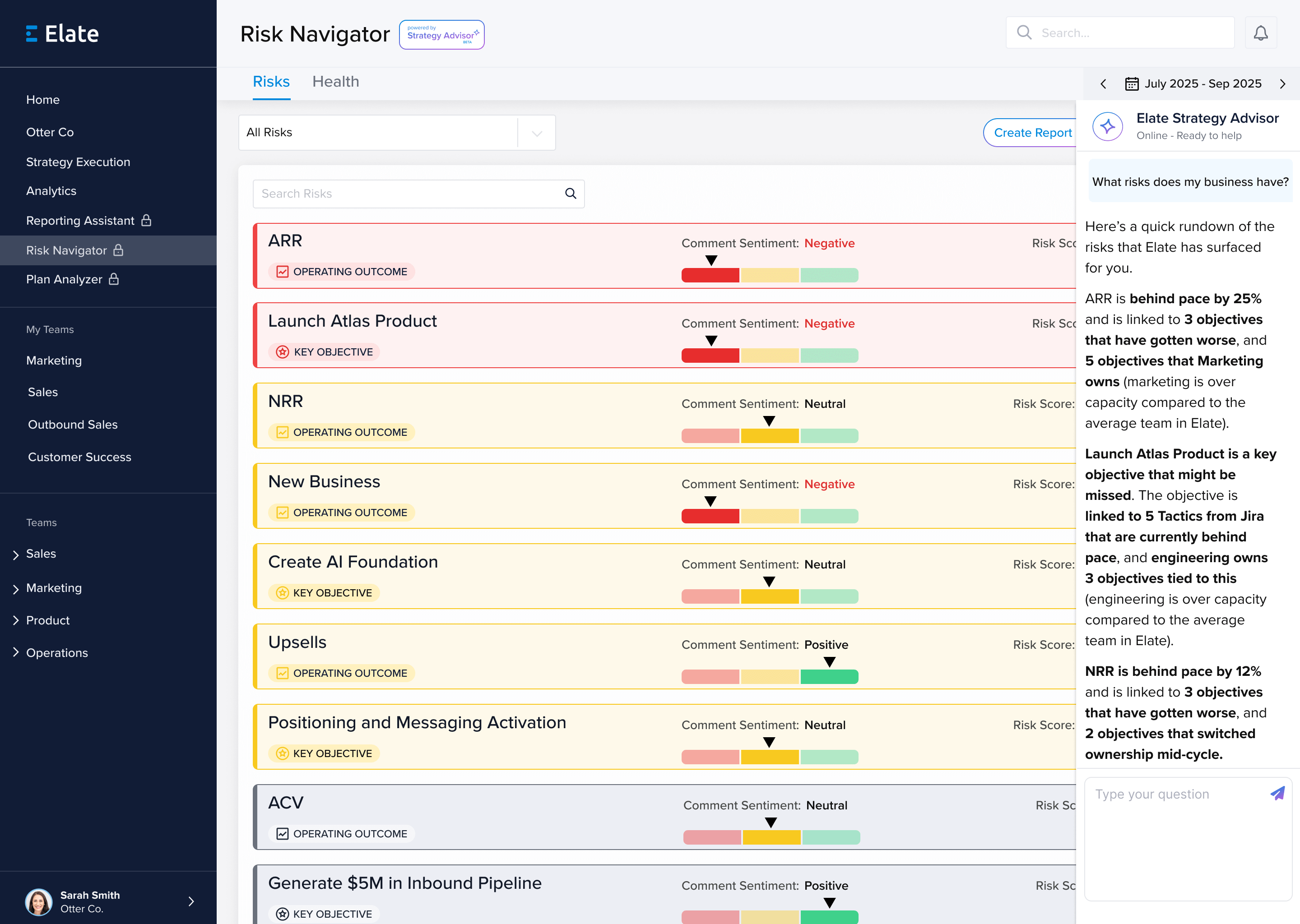With the rise in Strategic Planning as a competitive advantage for high growth companies, it is becoming more common for companies to embrace goal-setting frameworks to help drive execution towards a company's overall Strategic Plan.
One of the most popular goal-setting frameworks is the OKR Framework, which stands for Objectives and Key Results. First introduced by Andy Grove at Intel, OKRs have been gaining in popularity since being reintroduced by John Doerr in his book, Measure What Matters.
However, as the OKR framework is embraced by more companies, many strategy and operations leaders have struggled to find, implement, and successfully roll out the goal-setting framework.
At Elate, we have the opportunity to work with today's leading strategy and operations executives. From leaders in the COO and Chief of Staff position to VP of Operations and other strategy and operations leaders, we've heard countless stories of false starts and failed attempts to roll out OKRs.
One of the most common challenges we hear is the inability to properly set OKRs at the appropriate levels of the company. Far too often companies get consumed by trying to connect every OKR and ensure everyone has their own Objective that ties into even more Objectives.
Trying to build this structure can be maddening for leaders and confusing for employees new to OKRs.
To help counter this challenge, here at Elate we've placed a significant focus on properly building a Company OKR in a way that facilitates an intuitive structure throughout the rest of the organization.
From what we've seen, Company OKRs are usually overlooked or taken for granted in the OKR implementation process. However, we would argue that to truly deliver operational excellence OKRs, you must focus more on the Company OKRs than any other level of OKRs across the company.
Today, we'll share how we help strategy and operations leaders build and define Company OKRs.
OKR Framework
Let's begin by providing a reintroduction to the OKR framework, and how it can propel your business forward. Originally introduced as a model to help create company and employee alignment, OKRs provide structure to how companies set, execute, and review company priorities.
From aligning team members on key initiatives to establishing a healthy structure for how different initiatives are decided upon at every level of the business, the OKR framework can help drive communication, alignment, and visibility into overall performance.
The acronym 'OKR' stands for Objectives and Key Results, and the idea behind an OKR is that a team or individual is setting an Objective that aligns with the company's overall direction and priorities and has measurable Key Results that allow performance to be tracked.
While the OKR framework is unique for every company, the idea behind this framework is that Objectives can be set at different levels of the business, but that through each level OKRs are supporting one another. However, this idea of cascading OKRs can cause a number of different challenges and headaches for companies, especially as it relates to ensuring that meaningful, measurable Objectives are being set across the business.
From what we've seen at Elate, companies become so consumed with the idea of connecting every single Objective across the business, while also ensuring every employee has an Objective that it can in turn become overwhelming and detrimental to company growth.
Setting an OKR hierarchy is important, but should be done progressively, and in a way that aligns with what your business needs.
We always recommend starting by having leadership establish or reestablish their overall company mission, vision, and values. This should be done at least annually. From here, we recommend building annual company Themes that often serve as the rallying cries or ways your team thinks about success in a given year on your journey to reaching the long-term vision.
Once the mission, vision, values and themes have been set, now we can start setting our company OKRs. These company OKRs should be influenced and informed by data and perspective provided by employees across every department within the best. A solution like Elate makes it radically simple for employees to provide suggestions or insights into where a company may choose to double-down or shift resources away from as they continue to scale.
While it's important to provide employees a forum to influence company direction, ultimately leadership should be setting the Company OKRs. Once established, Department, Team, and Individual OKRs can be set in a way that aligns with Company OKRs.
However, if your company is new to OKRs, then don't try to roll out OKRs at every level. We recommend starting with Company and Department OKRs. Again, a solution like Elate will make it easy to share what OKRS are and why they are being used at your company by providing visibility to employees, but won't force employees to set OKRs without first understanding the value.
Now, let's take a look at some examples of Company OKRs.
Company OKR Examples
Different from specific department OKRs, such as customer success OKR examples or sales OKR examples, annual company objective examples bring together a number of other objectives and moving pieces across the business. With objectives uniquely built to accommodate specific departments, employees, and with a variety of different KPIs or metrics, it can be easy to overcomplicate your strategic objectives.
However, one pro tip we’ve seen that helps keep this process manageable: Keep it simple. Keep it clear.
For many companies, examples of short- and long-term goals for a business tend to be focused on a few key areas:
- Reaching revenue milestones
- Delighting Customers
- Building new products
- Creating an amazing culture
Each of these corporate objectives examples can be a great starting point. Frankly, bringing on new customers, delighting existing ones, delivering incredible products, and doing all this with an amazing culture are company goals and OKR examples for growth that most companies would strive to achieve.
But the key in any of these examples is also aligning the objective with the 'why' behind it. As an example:
'Build the industry-leading Planning Feature to help companies Propose, Review, and Finalize Company Objectives to bring together the entire Strategic Planning process.'
In this example, we know what we are building, why we are building it, and if done well, we should have key measurables that determine success across every team.
Setting company objectives should be simple, streamlined, and focused on the big priorities that all your department, team, and individual objectives should connect with. If your company objective is revenue driven try, something like:
'Reach $50M in ARR on our way towards becoming a $1B Strategic Planning platform, powering the growth of 10,000+ businesses.'
Again, a specific goal for this year, connected with the long-term vision. These aren't just KPIs being tracked, but they do have measurable results. So don't fall victim to thinking it's OKRs vs KPIs. Realistically OKRs entail tracking KPIs.
These are just some of the examples of how setting Company Objectives examples can connect the day-to-day execution with the long-term vision for the company.
Company OKR vs Team OKR
As we've highlighted, Company OKR vs Team OKR are very different. Team OKRs need to provide direction and focus for specific teams, and provide even more clarity for how individual OKRs are set by employees.
A team OKR may feel more like a KPI, but this is where the discussion of OKR vs KPI comes into play. While you might have specific metrics you are tracking, specifically if you are on the sales and marketing side of the house, don't forget that part of the power of OKRs is providing the context for the 'Why' of an OKR.
From reading any OKR book or even looking at a basic OKR template PDF, you will find that OKRs need to provide context. Whether they are Company OKRs, Team OKRs, or even individual OKRs, provide your employees with an OKR template that does more than just measure KPIs.
Elate helps provide a lightweight, intuitive structure that helps provide direction at every level of your company in how team members build OKRs. Again, we always recommend keeping the OKR framework and implementation process simple, but also ensure that you are creating enough structure for consistency.
Leading OKR Software
For those companies looking for startup OKR examples to help get your process off the ground, we're here to help.
Elate is the leading Strategic Planning software built to help high growth companies communicate their vision, create alignment, and track performance all in one place.
By partnering alongside companies on their journey of Strategic Planning, we also help as these companies implement and execute their OKR framework. But as was the case with Intel and even Google OKR examples, the overall framework shouldn't be a one-size fits all approach.
As we've learned, the OKR framework and how you set Company OKRs should be tailored towards your business. Growth goals, stage, and even culture all play an important role in helping to determine what OKRs or any goal-setting framework should look like for your company.
So as you set out on your OKR journey, reach out to our team today to see how we can help.











